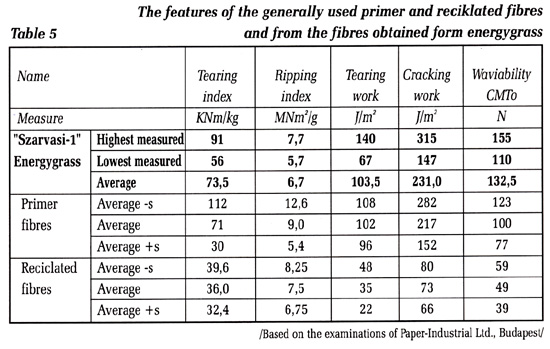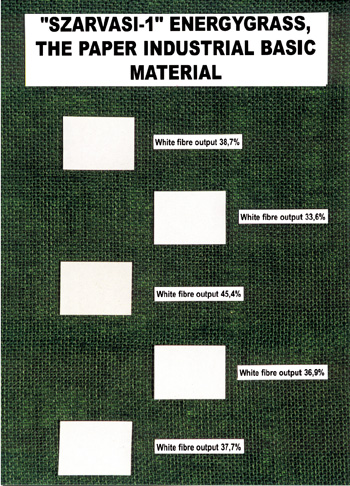|
|
THE UTILIZATION OF "SZARVASI-1" ENERGYGRASS IN PAPER INDUSTRY
Our institute does not only deal with the utilization of grass-kinds for energetical purposes, but also with the chance to utilize them in paper industry first in Europe.
It is generally known that the components of paper are vegetal tissues with solid cell wall, which is to be obtained from the plant during paper-manufacturing (raw cellulose), and to make it suitable for boardformation.
Our common programme with the Paper-Industrial Research Institute (2000) aims at both determining those components of "Szarvasi-1" energygrass, which are important for paper-making and finding out the extent the cellulose is suitable for paper-manufacturing.
The outcomes of our examinations have proved that the hollocellulose content of the "Szarvasi-1" energygrass approaches, or reaches the values of pine-kinds and broad-leaved trees. In order to determine the boardformation of the cellulose obtained from energygrass, the raw cellulose was ground in disc-milling machine, then classified on Lamont vibrating sieve, and from this suspension izo-dimension sheets were produced on Frank boardformation, where they measured the followings:
- Milling degree /according to Schopper-Riegler/
- Board density /kg/m3/
- Tearing features /Tearing power, tearing work/,
- Cracking pressure and work,
- Ripping power,
- The so-called CMT index, characterizing the waviness,
- Whiteness
According to laboratory examination we can assume that the boardformation ot the izo-dimensional sheets produced from "Szarvasi-1" energygrass is very favourable.
Its tearing and cracking work, and the CTM index (vawiness) are all more favourable that the sheets made from traditional paper-industry fibres, which might be very advantageous at producing wrapping materials with sliff wall.
We summarised in Table 5 the lowest and highest values of the fibres obtained from "Szarvasi-1" energygrass, the average values of the special features of the primer1 and reciktalt2 fibres, the values decreased with the scatter value /s/ from the average /average -s/, and increased /average 3s/ , determined in the accredited laboratory according to the Hungarian Paper-Manufacturing Research-Institute Ltd. EN 45001, in the framework of the EU research project, coordinated and controlled by the Grenoble, the French Paper-Industrial Research Institute CTP.
The data shown in Table 5 makes it possible to determine the relationship between the fibres that have been obtained from the "Szarvasi-1" energygrass and have been used in the paper-industry so far.
The examinations executed in the Paper-Industrial Research Institute extended to the examination of the outcome of the brown and white fibres obtained from "Szarvasi-1" energygrass, and to their boardformation.
The brown fibres obtained form the energygrass were whitened with the enviromental friendly QPaaPP sequence technology.
The successful whitening can be qualified according to the value of whiteness, outcome, granulometrical composition and runnability.

Note s=dispersion
Primer fibres1 = different traditional paper industrial fibres /pinecellulose, whitened board-leaved tree - cellulose, halfcellulose/, which are used in hunder thousand tons/year in the EU paper factories.
Reciclated fibres2 = German mixedpaper- fibres obtained from waste by French technology.
The whitened fibres' quantity /production/ was 33,6% counted on the raw material "Szarvasi-1" energygrass. The whiteness of the obtained, whitended fibres is 76,1%, its opacity is 91,5, which means that this value is similar to most industrial cellulose. Laboratory examinations have also proved that the tensile strength reaches, the rip strength exceeds the strawcellulose.
The white fibres obtained from energygrass are suitable for making writingprinting paper, or making microcrystal cellulose - which can be utilized in the medicine-, food-, and detergent industry.
It can be assumed, that the researches and results have been made so far have proved the usability of the "Szarvasi-1" energygrass in paper industry, and the competitiveness as an industrial raw material.
Utilization of the energygrass would provide reasonable alternative to rescue large forests, and would provide possibility to build paper industry where no forests exist.
Sheets formed by white fibres:

|
|
|


